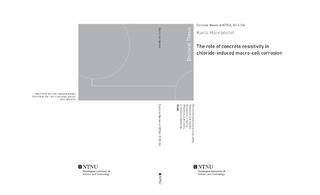| dc.contributor.author | Hornbostel, Karla | |
| dc.date.accessioned | 2016-01-08T11:26:30Z | |
| dc.date.available | 2016-01-08T11:26:30Z | |
| dc.date.issued | 2015 | |
| dc.identifier.isbn | 978-82-326-1305-2 | |
| dc.identifier.issn | 1503-8181 | |
| dc.identifier.uri | http://hdl.handle.net/11250/2373014 | |
| dc.description.abstract | Norwegian concrete structures are exposed to salt contamination from both sea water
and de-icing salts. Chlorides penetrate the concrete cover and initiate corrosion of the
reinforcement. The deterioration process can propagate at high rates and endanger
serviceability and structural safety. Concrete resistivity is usually assumed to correlate
closely with the corrosion process, and its measurement is in principle simple and costefficient,
and widely recommended to support service life assessment. However, the
extent to which concrete resistivity measurements can provide us with detailed
information about the corrosion process needs critical examination.
The main objective of this PhD project was to study the applicability of concrete
resistivity measurement for predicting the rate of reinforcement corrosion induced by
chlorides. A review of the literature led to the conclusion that a general correlation
could be found between increasing concrete resistivity and decreasing corrosion rate,
but a large scatter was observed within and between the studies reviewed. Various
possible reasons for the discrepancies were identified: researchers used dissimilar
procedures for determining both concrete resistivity and corrosion rate, and concrete
composition was recognised as affecting the overall tendency. Interestingly, the
literature contained very limited discussion on the mechanisms involved in providing
the correlation assumed between concrete resistivity and corrosion rate.
On the basis of the literature review, it seemed appropriate to investigate the
relationship between concrete resistivity and corrosion rate further using specially
designed laboratory experiments. In total, three experimental studies were conducted
using mortar to investigate the subject. The first study focused on the limitations of
measuring galvanic currents in macro-cells. It was confirmed that galvanic current
measurements provide an indication of the actual corrosion current, and thereby rate,
only if the actively corroding segment is sufficiently small.
The second experimental study investigated the limitations of bulk resistivity
measurements for predicting the ohmic resistance in a macro-cell between small anodes
and a large cathode network. It was found that for small anodes the ohmic resistance
between the anode and the cathode is not directly correlated with the bulk resistivity.
Local inhomogeneities strongly influence the measurements. The ratio between bulk
resistivity and the resistance between a specific anode and the cathode was not constant
over time and varied in particular with changes in the moisture conditions.
The third experimental study examined the influence of mortar resistivity on the ratelimiting
steps of chloride-induced corrosion. It was shown that for small anodes the
local conditions around the anode are more decisive for the anodic and ohmic partial
processes than the bulk resistivity. The cathodic partial process was found to be
practically independent of the mortar resistivity. For the setup and materials
investigated, it was not possible to identify any one rate-limiting step as dominant. The controlling rate-limiting step varied for the different materials investigated. For mortar
prepared with fly ash, and therefore possessing high mortar resistivity, the concept of
anodic-resistance control suggested in the literature was found to fit well. Cathodic
control was identified for mortars with a comparatively low bulk resistivity (prepared
only with Portland cement). Furthermore, it was confirmed that the generally assumed
inverse correlation between corrosion rate and concrete resistivity depends very much
on the material composition.
In conclusion, it was found that there can be no direct relationship between concrete
resistivity and the corrosion rate. The dependency on material composition and in
particular the fact that concrete resistivity is not directly correlated with the underlying
partial processes that determine the corrosion rate must be considered as decisive on this
question. It must therefore be assumed that the direct relationships between concrete
resistivity and corrosion rate introduced in the literature, and any models and general
threshold values based upon them, are not generally applicable. | nb_NO |
| dc.language.iso | eng | nb_NO |
| dc.publisher | NTNU | nb_NO |
| dc.relation.ispartofseries | Doctoral thesis at NTNU;2015:324 | |
| dc.relation.haspart | Paper 1:
Hornbostel, Karla; Larsen, Claus K; Geiker, Mette Rica.
Relationship between concrete resistivity and corrosion rate - A literature review. Cement & Concrete Composites 2013 ;Volum 39. s. 60-72
<a href="http://dx.doi.org/10.1016/j.cemconcomp.2013.03.019" target="_blank"> http://dx.doi.org/10.1016/j.cemconcomp.2013.03.019</a> | |
| dc.relation.haspart | Paper 2:
Hornbostel, Karla; Geiker, Mette Rica; Larsen, Claus K.
Application of segmented rebars for studying corrosion of steel in concrete. Proceedings Eurocorr 2013 | |
| dc.relation.haspart | Paper 3:
Hornbostel, Karla; Angst, Ueli Michael; Elsener, Bernhard; Larsen, Claus K; Geiker, Mette Rica.
On the limitations of predicting the ohmic resistance in a macro-cell in mortar from bulk resistivity measurements. Cement and Concrete Research 2015 ;Volum 76. s. 147-158
<a href="http://dx.doi.org/10.1016/j.cemconres.2015.05.023" target="_blank"> http://dx.doi.org/10.1016/j.cemconres.2015.05.023</a> | |
| dc.relation.haspart | Paper 4:
Hornbostel, Karla; Angst, Ueli M.; Elsener, Bernhard; Larsen, Claus K. and
Geiker, Mette R.
Influence of mortar resistivity on the rate-limiting step of chloride-induced
macro-cell corrosion of reinforcing steel | |
| dc.relation.haspart | Paper 5:
Hornbostel, Karla; Elsener, Bernhard; Larsen, Claus K.; Angst, Ueli M. and
Geiker, Mette R.
Limitations of the use of concrete resistivity as an indicator for the rate of
chloride-induced macro-cell corrosion | |
| dc.title | The role of concrete resistivity in chloride-induced macro-cell corrosion of reinforcement | nb_NO |
| dc.type | Doctoral thesis | nb_NO |
| dc.subject.nsi | VDP::Technology: 500::Building technology: 530::Construction technology: 533 | nb_NO |

